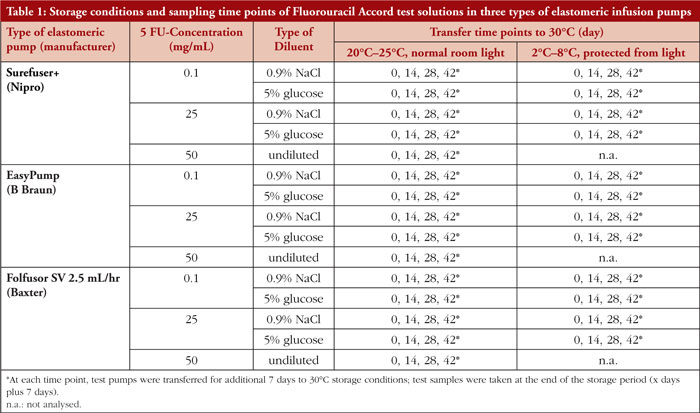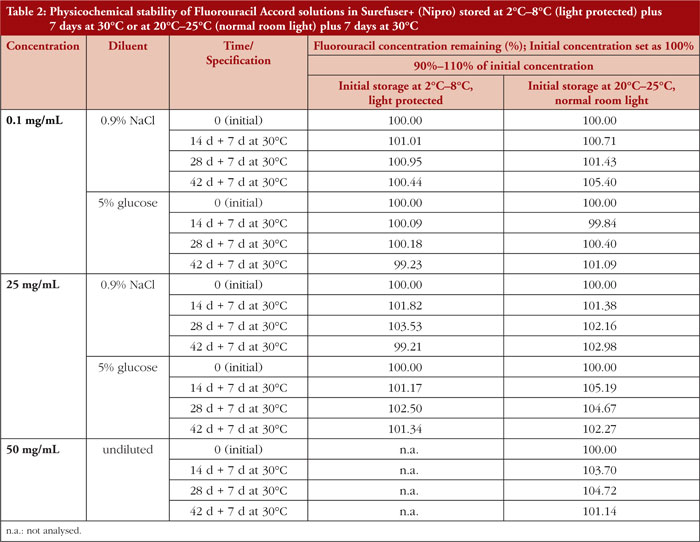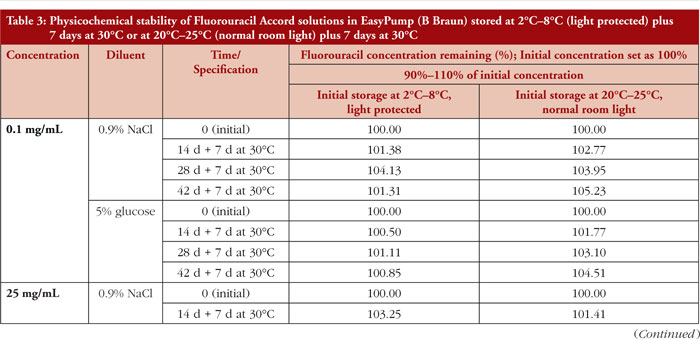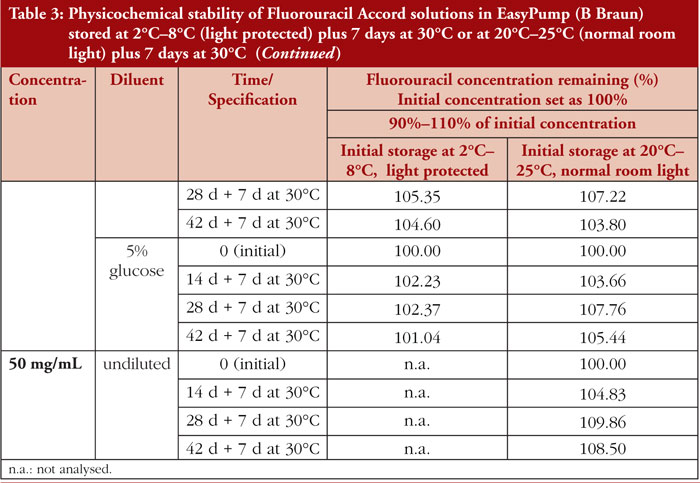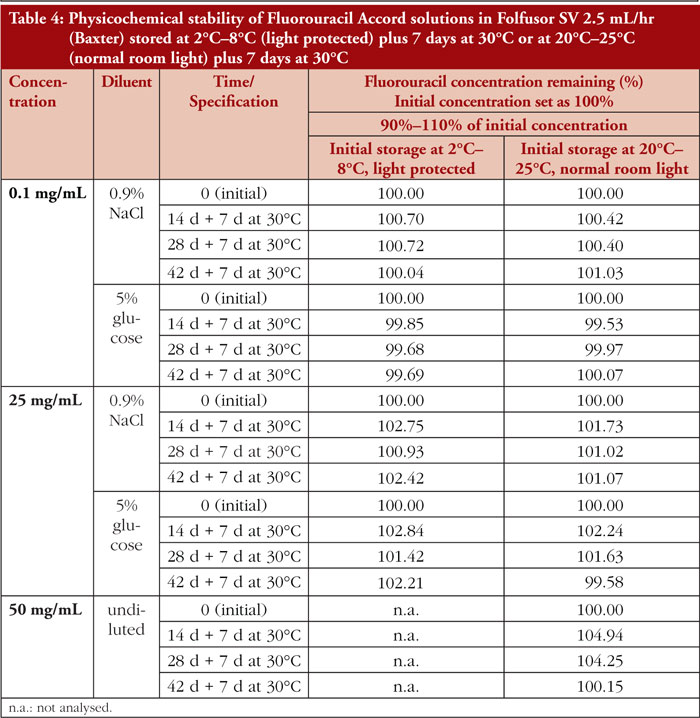Physicochemical stability of Fluorouracil Accord in three different concentrations in portable elastomeric infusion pumps
Published on 2024/09/11
Generics and Biosimilars Initiative Journal (GaBI Journal). 2024;13(2):107-10.
Author byline as per print journal: Irene Krämer, PhD; Frank Erdnuess, PhD; Judith Thiesen, PhD
|
Study objectives: To determine the physicochemical stability of Fluorouracil Accord 50 mg/mL solution for injection or infusion in three different types of elastomeric infusion pumps over 42 days, either undiluted (50 mg/mL) or after dilution with 0.9% sodium chloride or 5% glucose solution to concentrations of 0.1 mg/mL and 25 mg/mL. |
Submitted: 25 April 2024; Revised: 16 May 2024; Accepted: 21 May 2024; Published online first: 3 June 2024
Introduction
Fluorouracil is a pyrimidine antimetabolite that competes with uracil for incorporation into DNA, thereby blocking the cellular enzyme thymidylate synthetase. It is mainly used in combination with calcium or sodium folinate and oxaliplatin (FOLFOX [1]) or irinotecan (FOLFIRI [2]) for the treatment of various types of cancer, primarily colorectal, oesophageal, stomach, and anal cancers. In these regimens, high-dose fluorouracil is continuously infused via portable elastomeric pumps.
Physiochemical stability of several commercially available 5-FU products in elastomeric infusion pumps is reported for up to 28 days [3–5]. The summary of product characteristics of Fluorouracil Accord 50 mg/mL injection establishes its physicochemical stability over a 24-hour period when diluted to 0.98 mg/mL 5-FU with 0.9% sodium chloride or 5% glucose solution and stored at 25°C, regardless of the container material used [6].
Study objectives
The objective of the study was to determine the physicochemical stability of Fluorouracil Accord 50 mg/mL in three types of elastomeric infusion pumps (Surefuser+ (Nipro), Easypump (B Braun), Folfusor SV 2.5 mL/h (Baxter)) at three concentrations (50 mg/mL (undiluted), 0.1 mg/mL, and 25 mg/mL ( diluted with 0.9% sodium chloride or 5% glucose solution)) and stored at room temperature or under refrigeration for 42 days followed by 7 days at 30°C .
Methods
5-FU test solutions were prepared under EU Class A conditions and in accordance with the principles of Good Manu facturing Practice . Using the European Medicines Agency (EMA) licensed Fluorouracil Accord 50 mg/mL solution for injection or infusion (batch numbers PP00022 and PP00667) and three types of elastomeric infusion pumps, a total 15 different test solutions were prepared. The test solutions were stored at 20°C– 25°C without light protection (0.1 mg/mL, 25 mg/mL, 50 mg/mL 5-FU) or at 2°C– 8°C protected from light (0.1 mg/mL, 25 mg/mL 5-FU). At predetermined time points, see Table 1, a defined number of pumps were transferred to 30°C conditions and stored for an additional seven days (simulated infusion). Test samples were withdrawn at the end of the simulated infusion period and analysed.
The physical stability analysis of all test solutions was determined by pH measurements (using a glass electrode calibrated with standard buffer solutions) and by visual inspections under standard laboratory light for any changes in colour, clarity, or the presence of particulate matter.
The chemical stability was assessed via high-performance liquid chromatography (HPLC) assay, which has been validated for linearity of the analytical response and acceptable precision [7]. The assay was proven to be stability-indicating for non-specific degradation of the parent drug. Acceptance criteria were set at a concentration of ±10 % of the initial concentration [7]. In addition, related substances were analysed. Peaks in the HPLC chromatograms were identified by their relative retention times according to the 5-FU main peak, and concentrations were calculated. Acceptance criteria for the peaks were set as follows [7]:
- Barbituric acid (impurity A): </= 0.1%
- 5-hydroxy uracil (impurity B): </= 0.2%
- Single unknown impurity: </= 0.1%
- Total impurities: </= 0.8%
Results
Fluorouracil Accord solutions in elastomeric infusion pumps remained physically and chemically stable for 42 plus 7 days, regardless of the concentration (0.1 mg/mL, 25 mg/mL, 50 mg/mL), vehicle solution (undiluted, 0.9% sodium chloride, 5% glucose solution), and storage condition (20°C– 25°C without light protection, 2°C– 8°C light protected) used. The HPLC assays revealed only slight variations in 5-FU concentrations when test pumps were stored at 2°C– 8°C, see Tables 2-4. 5-FU concentrations in test pumps stored at 20°C– 25°C increased over the storage period, predominantly in solutions in Easypumps, see Tables 2, 3 and 4. Several peaks of related substances were observed in the HPLC chromatograms, but none exceeded the set limits. Two were identified as 5-hydroxyuracil (impurity B) and barbituric acid (impurity A). Single peaks of unknown impurities amounted to less than 0.08%, and total impurities amounted to less than 0.3% of the main peak (not shown in the tables). Neither colour changes, turbidity, nor visible particles were noticeable during visual inspection.
Conclusion
The physicochemical stability of Fluorouracil Accord 50 mg/mL in three types of elastomeric infusion pumps (Surefuser+, Nipro; Easypump, B Braun; Folfusor SV 2.5 mL/h, Baxter) at three concentrations (50 mg/mL undiluted, 0.1 mg/mL, 25 mg/mL, diluted with 0.9% sodium chloride, 5% glucose solution) was proven for 42 days storage, plus an additional 7 days of storage at 30°C to simulate infusion conditions.
Thus, Fluorouracil Accord infusion solutions in elastomeric pumps, with a concentration range of 0.1 mg/mL to 50 mg/mL, can be prepared in advance in pharmacy-based cytotoxic preparation units and stored for up to 42 days prior to administration. Samples were withdrawn after an additional 7 days of storage at 30°C to simulate elevated temperature conditions during administration. Storage at 2°C– 8°C is preferred due to enhanced microbiological stability and reduced evaporation of the vehicle solution.
Analysis was performed and documented by an accredited external laboratory. Results were carefully checked for plausibility and cautiously interpreted.
Funding sources
This study was funded by Accord Healthcare.
Competing interests: The authors Irene Krämer, Frank Erdnuess, and Judith Thiesen have no competing interests to declare.
Provenance and peer review: Not commissioned; externally peer reviewed.
Authors
Professor Irene Krämer, PhD
Frank Erdnuess, PhD
Judith Thiesen, PhD
Department of Pharmacy, University Medical Center of the Johannes Gutenberg University Mainz, 1 Langenbeckstraße, DE-55131 Mainz, Germany
References
1. de Gramont A, Figer A, Seymour M, Homerin M, Hmissi A, Cassidy J, et al. Leucovorin and fluorouracil with or without oxaliplatin as first-line treatment in advanced colorectal cancer. J Clin Oncol. 2000;18(16):2938-47.
2. Teufel A, Steinmann S, Siebler J, Zanke Ch, Hohl H, et al. Irinotecan plus folinic acid/continuous 5-fluorouracil as simplified bimonthly FOLFIRI regimen for first-line therapy of metastatic colorectal cancer. BMC Cancer. 2004;4:38 doi: 10.1186/1471-2407-4-38.
3. Roberts S, Sewell GJ. Stability and compatibility of 5-fluorouracil infusions in the Braun Easypump. J Oncol Pharm Pract. 2003;9(2-3):109-12.
4. Cadrobbi J, Hecq JD, Vanbeckbergen D, Jamart J, Galanti L, Stability of 5-fluorouracil and sodium folinate admixture. Hosp Pharm Eur. 2009;42:30-1.
5. Closset M, Onorati S, Colsoul ML, Goderniaux N, Bihin B, Jamart J, et al. Long-term physico-chemical stability of 5-fluorouracile at standardised rounded doses (SRD) in MyFuser® portable infusion pump. J Chemother. 2021;33(7):486-91.
6. Acco rd Healthcare Limited. Summary of product characteristics for Fluorouracil Accord 50 mg/mL Solution for Injection or Infusion [homepage on the Internet]. [cited 2024 May 16]. Available from: https://cdn.accord-healthcare.com/ie/public/spc/ie-spc-clean-v047.pdf
7. Accord Healthcare Limited. Data for HPLC assay and acceptance criteria on file; 09.10.2015.
|
Author for correspondence: Judith Thiesen, PhD, Department of Pharmacy, University Medical Center of the Johannes Gutenberg University Mainz, 1 Langenbeckstraße, DE-55131 Mainz, Germany |
Disclosure of Conflict of Interest Statement is available upon request.
Copyright © 2024 Pro Pharma Communications International
Permission granted to reproduce for personal and non-commercial use only. All other reproduction, copy or reprinting of all or part of any ‘Content’ found on this website is strictly prohibited without the prior consent of the publisher. Contact the publisher to obtain permission before redistributing.
